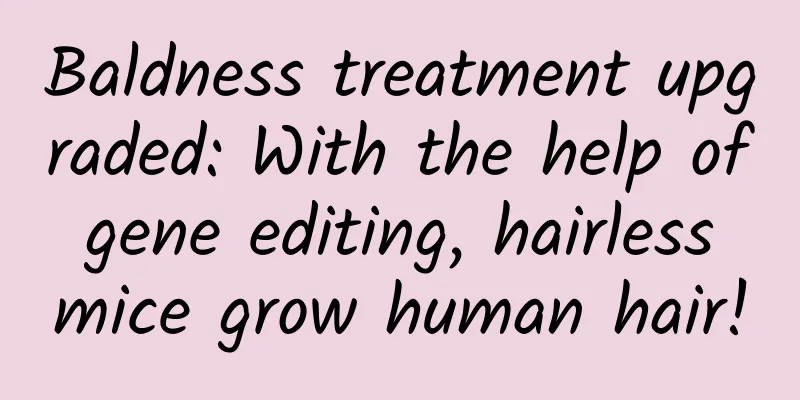Baldness treatment upgraded: With the help of gene editing, hairless mice grow human hair!

|
Written by: Hao Jing Editor: Kou Jianchao Layout: Li Xuewei “No more staying up late!!!” How many young people, after reluctantly putting down their mobile phones in the middle of the night, with dark circles under their eyes, silently swear in their hearts, "I will never stay up late again", and how many young people, after swearing over and over again, still pick up their mobile phones "without hesitation". However, "you will pay for what you have done", and the more nights you endure, the more hair you will have blown away by the wind like dandelions. Hair loss always comes suddenly, and my hairline gradually grows into the shape of a mobile phone screen. Nowadays, hair loss has become one of the most troublesome problems for contemporary young people, because hair loss greatly affects the image of young people. Fortunately, some recent studies have shown that scientists can treat baldness by reprogramming cells through genetic engineering. Ernesto Lujan, a biologist from Stanford University, said that his company DNOVO can genetically "reprogram" ordinary cells (such as blood or fat cells) to directly transform them into hair stem cells. The company's researchers have transplanted hair stem cells into mice, causing the hairless mice to grow human hair. Figure | Hairless mice grow a tuft of human hair after transplanting hair stem cells. (Source: DNOVO) This has proven that hair stem cells can indeed cause skin hair follicles to "redevelop" and grow new hair, but what is puzzling is why ordinary cells can become hair stem cells? "In biology, we can think of cells as a 'state' rather than a fixed identity, and genetic programming is about switching cells from one state to another," said Ernesto Lujan, founder of the company. This “cell state conversion” approach had a key breakthrough in the early 2000s, when Japanese researchers discovered a simple “formula” that could transform any type of tissue into powerful, embryonic-like stem cells. As a result, scientists realized they could create nearly any kind of cell. In practice, however, methods for making specific cell types were elusive, and there were difficulties in returning lab-grown cells to the human body. In addition to the "cell state conversion" method, Professor Karl Koehler from Harvard University used a completely different method to create hair stem cells - by growing organoids. When Professor Koehler was initially researching a treatment for deafness, he wanted to grow hair-like cells from the ear, but the organoids he grew ended up turning into skin with hair follicles. Although this was an accident, it was also a pleasant surprise, as it enabled Professor Koehler to cultivate spherical skin organoids that can grow for about 150 days, with a diameter of about 2 mm and clearly visible tubular hair follicles. Beyond that, the researchers are looking at cells from other donors to see if the organoids can give hair its unique color and texture. Figure | Skin organoids covered with hair follicles. (Source: Harvard Medical School) Professor Koehler said that although the hair grown in this way is ingrown, it also provides an important way to solve the problem of baldness. From this, it can be seen that although scientists have been working hard to find a way to treat hair loss and baldness, this road is still very far away. Professor Koehler said that using this method to treat hair loss needs to be customized (after all, everyone's DNA is different) and requires very high costs. Therefore, it is not feasible for ordinary people like us to save hair loss by transplanting hair stem cells. What we can do now is to find the cause of hair loss and then prescribe the right medicine. Causes of Hair Loss As the pressure of work and life increases, hair loss has become a common phenomenon among Chinese people. According to a survey, more than 250 million people in China are suffering from hair loss, which means that 1 in every 6 people has hair loss. (Take a quick look at your colleagues or classmates around you to see if there are any with hair loss) What’s even scarier is that among those with hair loss, those born after 1990 account for 39.9%! Women account for about 43.7% and men account for about 51.4%. I didn’t expect that they would start to suffer from hair loss at such a young age. (It’s quite “bald”) However, hair does not fall off whenever it wants. The six main factors of hair loss we are currently facing are: 1) Androgenic alopecia (seborrheic alopecia): This type of hair loss is related to genetics and male hormones and is permanent. The main manifestations are receding hairline and progressive reduction and thinning of hair on the top of the head. In a few cases, it is diffuse thinning of hair. 2) Immune deficiency alopecia: Immune deficiency alopecia is also called alopecia areata. The main feature is short-term non-trace hair loss with retained hair follicles; 3) Hair loss due to abnormal nutrition: When hair follicles do not get enough nutrition or when some nutrients are too much and produce cytotoxicity, hair may fall out; 4) Drug-induced hair loss: During chemotherapy treatment, cancer patients will suffer from damage to normal cells other than cancer cells, such as hair follicle cells, thus causing hair loss. 5) Hair loss due to endocrine disorders: postpartum, menopause, oral contraceptives, etc. can cause a lack of estrogen for a certain period of time and lead to hair loss; 6) Psychogenic hair loss: Due to excessive mental stress (including staying up late), the arrector pili muscles of the scalp contract, causing blood circulation disorders in the head, thus causing hair loss. Studies have also shown that excessive stress can secrete the stress hormone corticosterone, which inhibits the expression of the GAS6 gene, causing the hair follicles to remain in a resting state for a long time. (Source: Pixabay) Relevant research shows that the main reason for hair loss among those born after 1990 is staying up late and excessive stress, followed by lack of exercise and poor eating habits. When it comes to "repair" after hair loss, preventing hair loss is more important, after all, hair transplantation is expensive. Self-diagnosis and prevention of hair loss To prevent hair loss, you first need to determine whether you have a hair loss problem. The normal amount of hair loss for a normal person is about 50-100 strands per day. If you lose more than 100 strands of hair per day, it means that your hair may be leaving your scalp and is ready to "set sail". At this time, you need to pay attention and find out the cause of the hair loss. In addition to counting how many hairs you have lost, there is a simple way to test whether you have hair loss: use your thumb, index finger and middle finger to gently grab a small handful of hair from the root of the hair, and then gently pull it upwards, and repeat this action 5-6 times in different parts of the scalp. If you lose more than 3 hairs each time, there is a suspicion of hair loss. In addition to hereditary hair loss, hair loss caused by other external factors can still be avoided through some methods, including but not limited to: 1) Adjust your mentality: prevent hair loss caused by excessive stress, take a walk and do proper exercise which is beneficial to hair growth; 2) Ensure adequate sleep: Improving sleep quality can help improve hair loss; 3) Pay attention to nutritional balance: add foods high in protein to your diet; 4) Comb your hair every day: massage your scalp and promote blood circulation in the head. After reading this article, have you decided to have a good sleep? When the moon sleeps, you sleep too, don’t be a “bald little baby”! References: Academic headlines |
<<: Don’t be fooled by its beauty, it can bite off a lobster’s claws in one bite!
>>: How can group decision making go astray?
Recommend
Qian Xinmiao's "The Best Buying and Selling Strategy for Cyclical Stocks" Stock Trading Tutorial Video
Stock Lecture Training Course Video Lecture Intro...
Don't buy things with a long shelf life because they contain a lot of preservatives? Is this true?
Rumor: "Things with a long shelf life have a...
[2021 Summer] Senior 3 Physics Target A+ Model Physics Chapter Progress
[2021 Summer] Senior High School Physics Objectiv...
Activity case: How to conduct fission activities through product thinking?
In the second half of the Internet , the user div...
What is the secret to AO Smith’s success in innovation?
Mastering "core technology" is the capi...
Huawei, Apple, and Samsung's battle to end mobile phones
In the past 10 years, the rapid popularization of...
How to write copy that matches your brand positioning?
A few days ago, we held a small activity on the f...
Skills and strategies for new media operations!
New media operation concept mind map Through the ...
If Ms. Dong's Gree mobile phone wants to succeed, she still has to overcome these obstacles
Suddenly, it is hard to say whether it is hype or...
How do mini program development companies and mini program agents make profits?
How do mini program development companies and min...
Daily Fresh Product Analysis
With the development of the Internet, many servic...
The project of opening a public account and leaving a message on behalf of others is sold for 1799 yuan, with a profit of 500-2000 yuan per order [Video Tutorial]
The project of opening a public account message a...
Use e-cigarettes to quit smoking? Be careful! E-cigarettes are also harmful, and they contain drugs that harm the post-00s
Starting from July 1 this year, my country offici...
Sony PS VR head: The so-called VR killer app does not exist
Every time a new platform emerges in the technolo...
The core strategy of brand planning and promotion!
Previously, a netizen who is a planner came to me...





![[Creative Cultivation Program] Can intestinal flora be "contagious"? I love you, so I share my intestinal flora with you!](/upload/images/67f2412f48636.webp)



